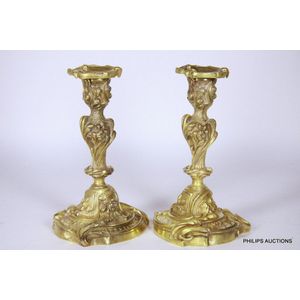Italian Gilt Putti Figural Stands, 18th Century
You must be a subscriber, and be logged in to view price and dealer details.
Subscribe Now to view actual auction price for this item
When you subscribe, you have the option of setting the currency in which to display prices to $Au, $US, $NZ or Stg.
- Floral Swag / Garland / Festoon - Floral swags are a decorative motif often used in the ornamentation of various objects, such as silverware, glassware, and furniture. The term "swag" refers to a garland or wreath of flowers, foliage, or other decorative elements, which is usually arranged in a loop or curve.
Floral swags can be found in a variety of decorative styles, from ornate Baroque and Rococo designs to more naturalistic Art Nouveau and Art Deco styles. They are often used to add a touch of elegance, refinement, or whimsy to an object, and can be seen on a range of items from chandeliers and candlesticks to picture frames and tea sets.
In the decoration of silver objects, floral swags are often used to accentuate the curves and lines of the piece, and to add visual interest to the surface. Similarly, on glass objects, floral swags may be used to frame or highlight a particular area of the object, or to add a touch of color and delicacy.
On furniture, floral swags can be found on a variety of pieces, from cabinets and armoires to chairs and sofas. They are often used to enhance the lines and curves of the furniture, and can be used to create a sense of movement and flow in the design.
Overall, floral swags are a versatile decorative element that can be adapted to a range of styles and applications, and have been used in the decoration of various objects throughout history. - Putto / Putti / Amorino / Amorini - A putto (plural: putti) or amerino (plural: amerini) is a cherub or cupid frequently appearing in both mythological and religious paintings and sculpture, especially of the Renaissance and Baroque periods and later used as a decorative element in the design of furniture, ceramics, statuary etc. They are usually depicted as chubby males, or of indeterminate gender, often with wings. Their depiction may represent an association with love, heaven, peace or prosperity.
This item has been included into following indexes:
Visually similar items

A large pair of neoclassical style garden urns and pedestals, the shaped stoneware trumpet urns both with a stiff leaf border to the rim, acanthus leaf and twin ram's head embellishments, gadrooned to the lower section and raised on plinth bases, height 15

A pair of large early 20th century brass ecclesiastical column candlesticks, wrythen twist bodies, large castellated cup form drip tray to the top, disc form central section, spreading circular bases. Height 54 cm

French 19th century bronze and ormolu candelabra, set with two sconces, resting upon a cupid, on a baluster support with fine palmette decoration on square foot, height 37 cm

A pair of French cast ormolu candlesticks, late 19th century, the knopped baluster sticks raised upon domed bases, lavishly cast and chased with vegetal and scrolling motifs in the rococo revival manner with Art Nouveau influences, height 20.5 cm
